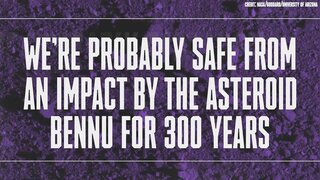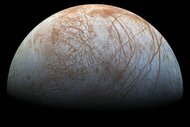Create a free profile to get unlimited access to exclusive videos, sweepstakes, and more!
Cometary Dust Smashed Tiny Craters into the Surface of Asteroid Ryugu
Hit or be hit, it's all asteroids know.
The 2021 science fiction disaster flick Asteroid (streaming now on Peacock) follows a family in the days after they move from the big city to a small town and a quiet life. The only problem is an asteroid is about to crush their new home.
Most of the time, this is the way we think about asteroids, as impactors from deep space threatening to smash into the planet and leave a smoldering crater behind, not to mention wiping out entire species and ecosystems in the process. Turns out, asteroids often get a taste of their own medicine in the form of tiny impactors scattered throughout space, according to a new study published in the journal Science Advances.
Scientists Find Tiny Impact Craters on the Surface of Asteroid Ryugu
The Japan Aerospace Exploration Agency (JAXA) sent their Hayabusa2 spacecraft to visit the asteroid Ryugu, pick up samples, and bring them home. The enterprising little spacecraft left Earth December 3, 2014 and arrived at Ryugu on June 27, 2018. It stuck around for about a year and a half, studying the asteroid from a close distance before snatching a sample and bringing it home in November 2019. Like NASA’s asteroid sample mission OSIRIS-REx (now OSIRIS-APEX), Hayabusa2 dropped off its sample before returning to deep space on its way to the next asteroid target.
RELATED: The Asteroid Ryugu is a Weird, Fragile Thing
Meanwhile, scientists here on Earth are busily studying the returned asteroid particles to get a better picture of how asteroids live. Analysis of the particles show that the asteroid itself has suffered impacts from micrometeors and interplanetary dust, leaving teeny tiny craters behind. Two particles in particular, designated A0067 and A0094, have mostly flat surfaces housing an array of micro craters and impact melt splashes. Analyzing the melt splashes reveals the nature of the impactors, which were consistent with cosmic dust smashing into the asteroid’s surface.
"Our 3D CT imaging and chemical analyses showed that the melt splashes consist mainly of silicate glasses with voids and small inclusions of spherical iron sulfides," said Megumi Matsumoto, assistant professor at Tohoku University and author of the new study, in a statement. "The chemical compositions of the melt splashes suggest that Ryugu's hydrous silicates mixed with cometary dust."
RELATED: Ryugu was born an asteroid, became a comet, and died an asteroid
As Ryugu races through interplanetary space on its path around the solar system, it’s plowing headlong into tiny bits of rock and dust scattered throughout our cosmic neighborhood. That dust smears itself onto the surface of the asteroid like bugs on a windshield, leaving their chemical guts for scientists to find. In the same way that bugs and bug guts hitch a ride on your car, sometimes traveling incredible distances from their point of origin, the study authors note that material mixing between asteroids and cosmic dust could be a mechanism for transporting organic molecules from deep space to the surface of planets.
"We propose that the carbonaceous materials formed from cometary organic matter via the evaporation of volatiles, such as nitrogen and oxygen, during the impact-induced heating. This suggests that cometary matter was transported to the near-Earth region from the outer solar system. This organic matter might be the small seeds of life once delivered from space to Earth,” said Matsumoto.
Asteroid impacts might be seen as harbingers of death today, but in the solar system’s past they may have been the boost we needed to get this little party going in the first place.
Asteroids aren’t all bad, they make for fun movies. Catch Asteroid, streaming now on Peacock.































